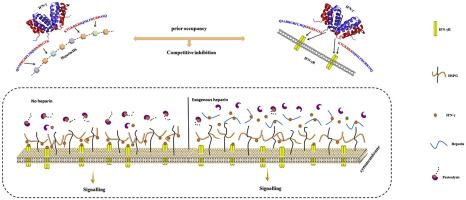Our official English website, www.x-mol.net, welcomes your
feedback! (Note: you will need to create a separate account there.)
The role of heparin/heparan sulphate in the IFN-γ-led Arena.
Biochimie ( IF 3.3 ) Pub Date : 2019-11-30 , DOI: 10.1016/j.biochi.2019.11.018 Kening Xu 1 , Lan Jin 1
Biochimie ( IF 3.3 ) Pub Date : 2019-11-30 , DOI: 10.1016/j.biochi.2019.11.018 Kening Xu 1 , Lan Jin 1
Affiliation

|
IFN-γ (Interferon-gamma) is a pleiotropic cytokine. It is often involved in a variety of physiological processes by binding to the cell surface transmembrane receptor (IFN-γR) to initiate a series of signalling pathways that transmit external signals from cell surface receptors to the cell nucleus. Heparan sulphate (HS), a highly sulphated linear polysaccharide, is ubiquitous on the mammalian cell surface and extracellular matrix. Electrostatic interactions can be generated between the highly sulphated HS region and specific basic amino acid residues in the IFN-γ structure, thereby detaining IFN-γ on the cell surface, and the concentration of IFN-γ on the cell surface is thus, changed. IFN-γ retained on the cell surface will optimize the binding of IFN-γ to the transmembrane receptor resulting in high efficiency signalling. Heparin is a glycosaminoglycan with a structure similar to HS. The structural similarity provides a basis for modelling exogenous heparin dependence for interference with IFN-γ function. This model can be summarized as follows: First, the competitive binding effect; heparin bound to cytokines by competing with membrane-associated HS, causes a decrease in cytokine concentration on the cell surface. Second, the principle of priority occupancy; heparin can occupy the receptor binding site on cytokines, partially preventing the IFN-γ-IFN-γR interaction. These two models interfere with IFN-γ signal transmission. To decipher the mechanism by which heparin influences IFN-γ activity, studies of the structure-activity relationship are in progress. This paper summarizes research progress on the IFN-γ signalling pathway, heparin interference with IFN-γ activity and the structure-activity relationship between heparin and IFN-γ.
中文翻译:

肝素/硫酸乙酰肝素在IFN-γ主导的Arena中的作用。
IFN-γ(干扰素-γ)是多效性细胞因子。它通常通过与细胞表面跨膜受体(IFN-γR)结合来启动一系列信号传导途径,从而将外部信号从细胞表面受体传递到细胞核,从而参与各种生理过程。硫酸乙酰肝素(HS)是一种高度硫酸化的线性多糖,在哺乳动物细胞表面和细胞外基质中普遍存在。可以在高度硫酸化的HS区与IFN-γ结构中特定的碱性氨基酸残基之间产生静电相互作用,从而将IFN-γ保留在细胞表面,从而改变了细胞表面IFN-γ的浓度。保留在细胞表面的IFN-γ将优化IFN-γ与跨膜受体的结合,从而产生高效信号。肝素是具有类似于HS的结构的糖胺聚糖。结构相似性为建模外源肝素依赖性干扰IFN-γ功能提供了基础。该模型可以概括如下:一是竞争约束力;二是竞争约束力。肝素通过与膜相关HS竞争而与细胞因子结合,导致细胞表面细胞因子浓度降低。二,优先占用原则;肝素可占据细胞因子上的受体结合位点,部分阻止IFN-γ-IFN-γR相互作用。这两个模型会干扰IFN-γ信号的传输。为了破译肝素影响IFN-γ活性的机制,有关结构-活性关系的研究正在进行中。本文总结了IFN-γ信号通路的研究进展,
更新日期:2019-11-30
中文翻译:

肝素/硫酸乙酰肝素在IFN-γ主导的Arena中的作用。
IFN-γ(干扰素-γ)是多效性细胞因子。它通常通过与细胞表面跨膜受体(IFN-γR)结合来启动一系列信号传导途径,从而将外部信号从细胞表面受体传递到细胞核,从而参与各种生理过程。硫酸乙酰肝素(HS)是一种高度硫酸化的线性多糖,在哺乳动物细胞表面和细胞外基质中普遍存在。可以在高度硫酸化的HS区与IFN-γ结构中特定的碱性氨基酸残基之间产生静电相互作用,从而将IFN-γ保留在细胞表面,从而改变了细胞表面IFN-γ的浓度。保留在细胞表面的IFN-γ将优化IFN-γ与跨膜受体的结合,从而产生高效信号。肝素是具有类似于HS的结构的糖胺聚糖。结构相似性为建模外源肝素依赖性干扰IFN-γ功能提供了基础。该模型可以概括如下:一是竞争约束力;二是竞争约束力。肝素通过与膜相关HS竞争而与细胞因子结合,导致细胞表面细胞因子浓度降低。二,优先占用原则;肝素可占据细胞因子上的受体结合位点,部分阻止IFN-γ-IFN-γR相互作用。这两个模型会干扰IFN-γ信号的传输。为了破译肝素影响IFN-γ活性的机制,有关结构-活性关系的研究正在进行中。本文总结了IFN-γ信号通路的研究进展,











































 京公网安备 11010802027423号
京公网安备 11010802027423号